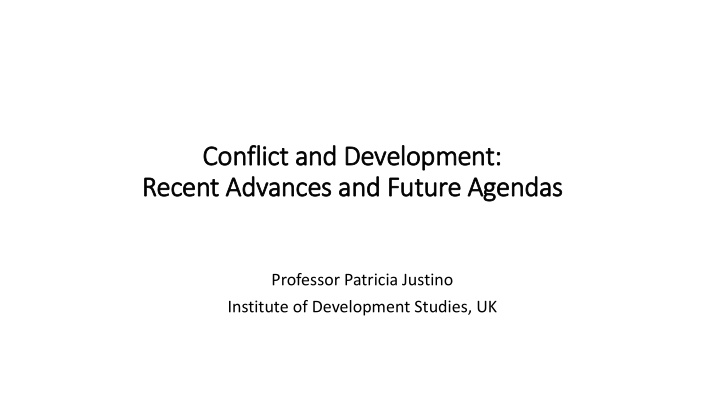



Confl flict and Development: Recent Advances and Future Agendas Professor Patricia Justino Institute of Development Studies, UK
Where we are • Three main advances in recent research on conflict and violence: • shift from state-level to more micro-levels of analysis • importance of civilian agency in conflict contexts • role of wartime institutions
Sh Shift fr from state-level to mic icro-level • During 1980s and 1990s: focus on security and capacity of states: • Useful in advancing understanding of global patterns that drive conflict • Limited attention to individuals beyond humanitarian needs • Less useful in uncovering mechanisms that may explain sub-national patterns • Recent focus on people and communities affected by violent conflict (www.microconflict.eu; www.hicn.org) : • wealth of rigorous evidence, data and analysis: hh, spatial, behavioural • consequences of violent conflict closely interrelated with how people and groups behave, make choices, and interact • Greater importance of people-centred approaches to conflict among international organisations
Civilian agency • Civilians constitute the bulk of the victims of armed conflict but: • Many build tremendous resilience in the face of violence • Choices and behaviour (voluntary or involuntary) shape dynamics of conflict on the ground: where to fight, with whom, and for how long • Experiences of recruitment and victimization may result in: • Increased individual political and social participation and leadership once the war is over (Bellows and Miguel 2009, Blattman 2009) • Stronger forms of altruism and social cooperation (Voors et al. 2010) • Latest results are mixed but overall: civilian experiences of violence beyond victimisation may be central to how social relations and political structures are organized during and after violent conflict
Wartime in institutions and th the role of f armed groups • Armed conflict theorised as a departure from social order rather than intrinsic to the creation and change of institutions • Large literature on armed conflict as a symptom of ‘state collapse’ or ‘state failure’ • But the collapse of state institutions not always associated with the collapse of order • In reality political actors occupy the space left by weak or absent state institutions by building new institutions that advance war objectives – can be violent but not everywhere nor at all times. Egs: FARC, LTTE, Hamas, Hezbolah, Taliban. In common: v. persistent • Promising new areas of research: • Effect of rebel governance on welfare outcomes (Arjona, Mampilly): Implications for reintegration of ex-combatants and war-affected civilians? How do we deal with non- state actors in the post-conflict period? • Effect of conflict on social norms and cooperation (Bauer, Cassar, Bowles): Does conflict induce more or less pro-social behaviour? How do preferences and attitudes change? What is the effect of these changes on conflict re-ignition?
Fu Future agendas • Linking micro and macro levels of analysis • Need for better data collection and evaluation systems • Understanding violence and conflict beyond civil wars – and beyond failed states
Li Linking mic icro and macro • Can micro-level findings provide true foundations to understand macro phenomena? • Why conflict persists, mutates, and how peace may emerge • Survival and security of ordinary people • How to negotiate with, engage and understand complex distributions of power within populations in conflict-affected contexts • Linking micro and macro through meso-level processes (Balcells and Justino, JCR special issue) • Technologies of rebellion (Balcells and Kalyvas) • Wartime institutions as a result of interactions between civilians and armed groups (Arjona, Mampilly) • Civilian organisation and local collective action (Arjona, Cardenas, Ibanez and Justino) • Local political interactions and patronage systems (Gutierrez-Romero) • Local markets and business interactions (Ahmed)
Better data collection and evaluation systems • Great advances but evidence remains sparse, scattered, based on case studies • Policy interventions in conflict affected contexts rarely evaluated and monitored rigorously (though changing rapidly) • Comparable evidence across different conflict-affected contexts: • Investment in appropriate methodological systems • Engagement between researchers, the international policy community and local governments (including statistical offices)
Vio iolence happens outside Afr frica and outside civil wars • Conflict research dominated by the analysis of a restricted number of failed states ridden by civil wars – mostly in Africa • Not useful in identifying the mechanisms that may explain why some conflict-affected countries have historically been able to successfully transition to peace and stability, while others remain trapped in cycles of violence and insecurity • Need to shift the focus of conflict analysis to countries where some of these processes of transition are currently taking place: • most of the world’s violence takes place in non-fragile countries • the rising importance of urban violence • rise of violent protests and social tensions: Arab Spring, food riots, protests against austerity etc
Recommend
More recommend